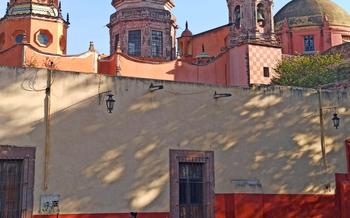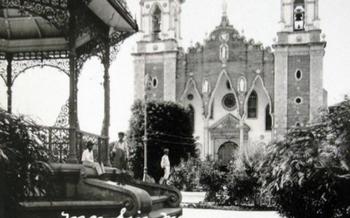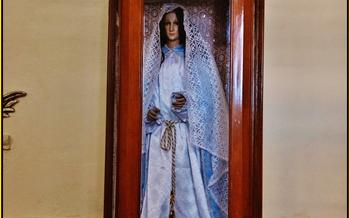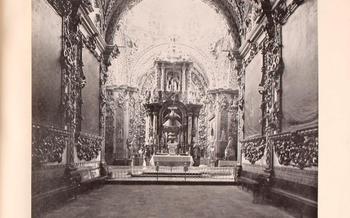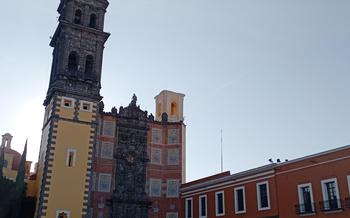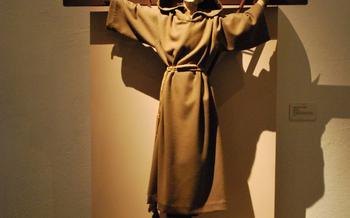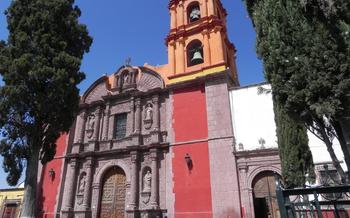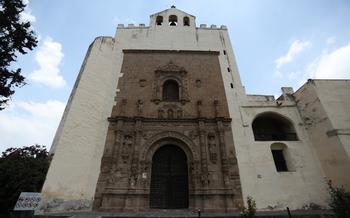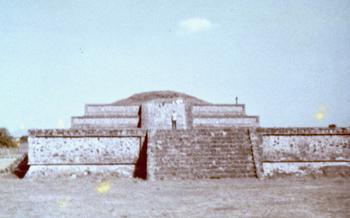
Iglesia de San Pedro
- Iglesia de San Pedro: A Baroque Masterpiece in Puebla
- Intricate Façade: A Symphony of Stone
- Majestic Towers: Reaching for the Heavens
- Stunning Altars: A Feast for the Eyes
- Captivating Murals: A Journey Through Time
- Sacred Spaces: Chapels and Sacristies
- Plaza de San Pedro: A Vibrant Square
- Festivals and Celebrations: Honoring Tradition
- Guided Tours: Unveiling Hidden Gems
- Photography Tips: Capturing the Grandeur
- Accessibility: Ensuring Inclusivity
- Dress Code: Respecting Local Customs
- Insider Tip: Unveiling a Hidden Gem
Iglesia de San Pedro: A Baroque Masterpiece in Puebla
Nestled in a resplendent testament to the city's rich colonial heritage and architectural prowess. Constructed between 1690 and 1700, this magnificent Baroque masterpiece is a symphony of stone, a testament to the city's deep-rooted Catholicism, and a symbol of Puebla's enduring cultural and religious significance.
The church's history is intertwined with the origins and development of Puebla, founded in 1531 by Spanish conquistadors. As the city flourished, so too did its religious institutions, with the Iglesia de San Pedro emerging as one of the most important and revered churches in the region. Its construction was a testament to the city's growing wealth and influence, and it quickly became a focal point of religious and cultural life in Puebla.
Architecturally, the Iglesia de San Pedro is a stunning example of Mexican Baroque, characterized by its intricate carvings, flamboyant ornamentation, and soaring spires. Its façade is a masterpiece of Churrigueresque architecture, a style that emerged in Spain during the 17th century and spread throughout the Spanish colonies. This exuberant style, known for its profusion of decorative elements, is evident in the church's elaborate façade, which features a wealth of sculptures, reliefs, and intricate stonework.
Intricate Façade: A Symphony of Stone
The façade of the Iglesia de San Pedro is a remarkable display of Baroque architecture, showcasing intricate carvings and sculptures that tell a captivating story in stone. Detailed biblical scenes, mythical creatures, and cherubs adorn the façade, each element meticulously crafted to convey religious messages and inspire awe in the beholder.
The symbolism employed in the carvings is profound, drawing on biblical references and local legends. The central niche houses a sculpture of Saint Peter holding a key, symbolizing his role as the gatekeeper of heaven. Flanking him are statues representing the four evangelists, each accompanied by their respective symbols: a lion for Mark, an ox for Luke, an eagle for John, and a human for Matthew.
The indigenous influence is evident in the unique interpretation of biblical scenes. The artisans who worked on the façade incorporated elements of their own culture, resulting in a blend of European and indigenous artistic traditions. This fusion is particularly visible in the depiction of the angels, whose features and garments reflect the local indigenous heritage.
The façade of the Iglesia de San Pedro is a testament to the skill and artistry of the stonemasons and sculptors who created it. Its intricate details and profound symbolism invite visitors to contemplate the stories and messages embedded in the stone, offering a glimpse into the rich cultural and religious heritage of Puebla.
Majestic Towers: Reaching for the Heavens
The Iglesia de San Pedro boasts two majestic towers that soar towards the heavens, symbolizing the church's connection to the divine. These towers, each reaching a height of over 60 meters, dominate the cityscape and offer breathtaking views of the surrounding area. Visitors can ascend the narrow spiral staircases to the bell towers, where they are rewarded with a panoramic vista that encompasses the city of Puebla, the Sierra Madre Oriental mountain range, and the distant volcanoes. The ringing of the bells, which can be heard echoing throughout the city, adds to the spiritual ambiance of the church and serves as a reminder of its enduring presence.
Stunning Altars: A Feast for the Eyes
Stepping inside the Iglesia de San Pedro, visitors are captivated by the breathtaking array of altars that adorn the interior. Each altar is a masterpiece of artistry, crafted with intricate carvings, gold leaf, and vibrant colors. The main altar, or retablo mayor, is a towering structure that dominates the chancel. It features a series of niches that house sculptures of saints and religious figures, all rendered in exquisite detail. The smaller side altars, dedicated to various saints, are equally impressive, showcasing the skill and devotion of the artisans who created them.
The altarpieces, or retablos, are particularly noteworthy for their intricate carvings and gold leaf embellishments. The retablos depict scenes from the Bible and the lives of the saints, bringing to life the stories of faith and devotion. The use of gold leaf adds a touch of opulence and grandeur to the altars, creating a sense of awe and reverence.
Each altar tells a unique story, inviting visitors to contemplate the lives and teachings of the saints. Whether it's the serene figure of the Virgin Mary or the powerful presence of Saint Peter, the altars offer a glimpse into the rich history and traditions of Catholicism in Puebla.
Captivating Murals: A Journey Through Time
The Iglesia de San Pedro is adorned with breathtaking murals that depict religious scenes and narratives, inviting visitors on a journey through time. These murals, painted by talented local artists, serve as visual masterpieces that convey profound symbolism and hidden meanings. Each mural tells a story, capturing moments from the Bible and the lives of saints, offering a glimpse into the rich history and beliefs of the Catholic faith.
The technique and artistry employed in these murals are remarkable, showcasing the skill and devotion of the artists. The vibrant colors, intricate details, and lifelike figures bring the stories to life, creating a sense of awe and inspiration. Visitors can spend hours admiring the murals, uncovering the hidden symbols and allegories that add depth and meaning to the artwork.
One of the most striking murals portrays the Last Supper, depicting Jesus and his disciples gathered around a table, sharing a final meal before his crucifixion. The expressions on the faces of the disciples convey a range of emotions, from contemplation to sorrow, capturing the gravity of the moment.
Another notable mural depicts the Assumption of the Virgin Mary, showcasing the Virgin Mary being lifted into heaven by a host of angels. The ethereal beauty of the scene, with Mary's radiant figure surrounded by celestial light, is a testament to the artist's skill and devotion.
These murals are not merely decorative elements; they are integral to the church's identity and serve as a powerful tool for religious education and inspiration. They offer a unique perspective on the history and beliefs of the Catholic faith, inviting visitors to contemplate the spiritual and artistic heritage of Puebla.
Sacred Spaces: Chapels and Sacristies
Within the Iglesia de San Pedro, smaller chapels, each dedicated to a different saint or purpose, offer a journey through the church's history and devotion. The Chapel of the Third Order, with its intricate altarpieces and stained glass windows, exudes a sense of serenity and reflection. The Chapel of the Virgin of Guadalupe, adorned with colorful murals and offerings, showcases the deep devotion of the local community. The sacristies, with their meticulously organized vestments, sacred vessels, and historical artifacts, provide a glimpse into the daily rituals and traditions of the church. These sacred spaces invite visitors to delve deeper into the spiritual and cultural significance of the Iglesia de San Pedro.
Plaza de San Pedro: A Vibrant Square
The Iglesia de San Pedro is nestled in the heart of the bustling Plaza de San Pedro, a vibrant square that serves as the social and cultural hub of the surrounding neighborhood. The plaza is a melting pot of activities, where locals and tourists alike converge to experience the essence of Puebla's rich history and culture.
The square is adorned with a colorful array of market stalls, where vendors display their wares, from traditional handicrafts to mouthwatering local delicacies. The air is filled with the sounds of lively banter, the aroma of freshly prepared food, and the infectious rhythms of traditional Mexican music.
In the evenings, the plaza transforms into a vibrant entertainment hub, as street performers showcase their talents, captivating audiences with their music, dance, and acrobatics. The square also hosts cultural events and performances throughout the year, providing a platform for local artists to showcase their creativity and connect with the community.
Strolling through the Plaza de San Pedro is a feast for the senses, offering a glimpse into the vibrant tapestry of Puebla's daily life. Whether you're seeking unique souvenirs, savoring local culinary delights, or simply soaking up the infectious energy of the city, the Plaza de San Pedro is an unmissable destination.
Festivals and Celebrations: Honoring Tradition
The Iglesia de San Pedro is not just a place of worship; it is also a vibrant hub for religious festivals and celebrations that honor local traditions and bring the community together. During these special events, the church transforms into a stage for colorful processions, traditional music, and cultural performances.
One of the most significant celebrations is the annual feast of San Pedro, the patron saint of the church. This grand event takes place on June 29th and attracts thousands of pilgrims from all over the region. The church is adorned with flowers, streamers, and intricate carpets made from colored sawdust. The air is filled with the sounds of music, prayers, and the joyous laughter of the faithful.
Holy Week, coinciding with Easter, is another time of great religious fervor. The church hosts solemn processions, reenactments of the Passion of Christ, and special masses to commemorate the crucifixion and resurrection of Jesus. These events are deeply rooted in the local culture and offer a profound insight into the spiritual traditions of the region.
Throughout the year, the Plaza de San Pedro comes alive with various cultural events and performances. From traditional dance troupes to mariachi bands, there is always something to delight and entertain visitors. These events showcase the vibrant cultural heritage of Puebla and provide a glimpse into the everyday life of its people.
Guided Tours: Unveiling Hidden Gems
For a truly immersive experience, consider embarking on a guided tour of the Iglesia de San Pedro. Knowledgeable guides will lead you through the church's intricate spaces, shedding light on its history, architecture, and religious significance. They'll point out hidden details you might miss on your own, such as symbolic carvings, biblical references, and fascinating anecdotes about the church's past.
Joining a guided tour offers a deeper understanding of the church's cultural and religious importance. Guides can provide insights into the symbolism and stories depicted in the murals, altarpieces, and sculptures, bringing the church's rich history to life. They can also explain the significance of the various chapels and sacristies, and how they were used in the past.
Whether you're a history buff, an architecture enthusiast, or simply someone who appreciates beautiful spaces, a guided tour of the Iglesia de San Pedro is an unforgettable experience. It's a chance to discover the hidden gems of this architectural masterpiece and gain a deeper appreciation for its role in shaping the cultural and religious heritage of Puebla.
Photography Tips: Capturing the Grandeur
Iglesia de San Pedro offers ample opportunities for stunning photography, allowing you to capture the intricate details and grandeur of this architectural masterpiece.
- Best Angles and Lighting:
- Position yourself in front of the church to capture the full façade, ensuring you have enough space to include the majestic towers.
-
For optimal lighting, visit during the golden hours of sunrise or sunset when the warm hues enhance the beauty of the stone carvings.
-
Permits and Restrictions:
- Photography is generally permitted within the church, but using a tripod or flash may require special permission.
-
Respect the privacy of worshippers and avoid taking photos during religious services or events.
-
Capturing the Essence:
- Experiment with different angles and perspectives to showcase unique features, such as the intricate carvings on the towers or the ornate details on the doorways.
- Include people in your shots to convey the scale and grandeur of the church, adding a human element to your compositions.
Accessibility: Ensuring Inclusivity
The Iglesia de San Pedro is committed to providing an inclusive environment for visitors of all abilities. Wheelchair ramps and designated seating areas ensure that those with mobility challenges can comfortably explore the church's grandeur. Audio guides and other assistive devices are available to enhance the experience for visitors with visual or hearing impairments. The church staff is dedicated to assisting visitors with any special needs, ensuring that everyone can appreciate the beauty and history of this sacred space.
Dress Code: Respecting Local Customs
When visiting the Iglesia de San Pedro, it is essential to dress appropriately, adhering to local customs and traditions. Puebla's culture is deeply rooted in Catholicism, and the church holds a sacred and revered position in the community. As a visitor, showing respect for local customs and traditions is crucial.
Opt for modest and conservative attire that covers your shoulders and knees. Avoid wearing shorts, tank tops, or revealing clothing that may be deemed disrespectful in such a sacred space. Dressing appropriately demonstrates your understanding and appreciation of the religious significance of the church and the local culture.
Remember, the purpose of your visit is to admire the architectural beauty, historical significance, and religious symbolism of the church, not to draw attention to yourself through inappropriate attire. By dressing respectfully, you show your reverence for the site and contribute to a harmonious and respectful atmosphere within the church.
Insider Tip: Unveiling a Hidden Gem
For those seeking an unforgettable experience, the Iglesia de San Pedro holds a secret passage that leads to a breathtaking view of the city. Hidden within the walls of the church, this passageway is a testament to the architectural ingenuity and beauty that lies beyond the main sanctuary. To access the passage, visitors should head to the sacristy and inquire about the possibility of a guided tour. The knowledgeable guides will lead you through a series of narrow corridors and staircases, revealing the hidden treasures of the church along the way. As you emerge from the passage, you will be greeted by a panoramic vista of Puebla, with its colorful colonial buildings, bustling streets, and the majestic volcanoes in the distance. This secret viewpoint offers a unique perspective of the city and is a must-visit for anyone seeking a deeper connection to the history and beauty of Puebla.
